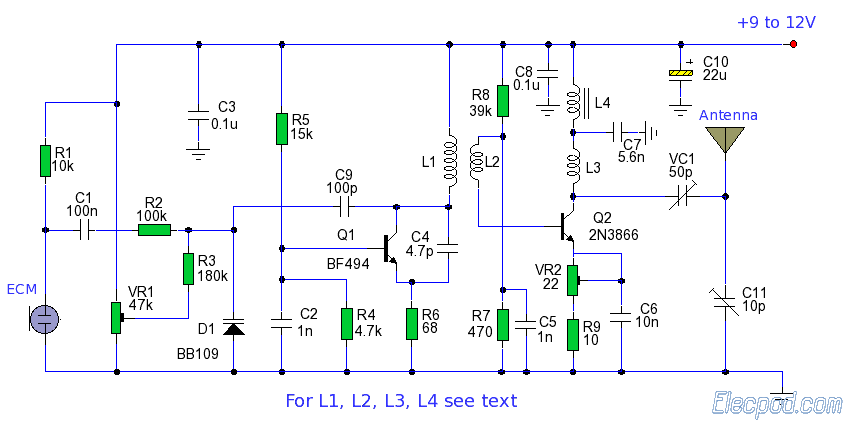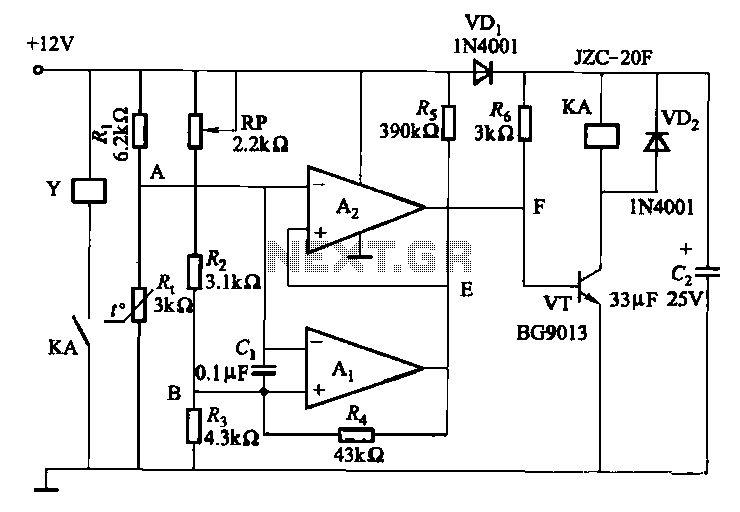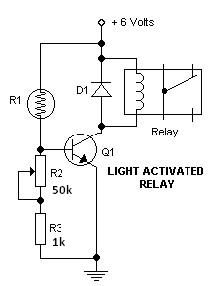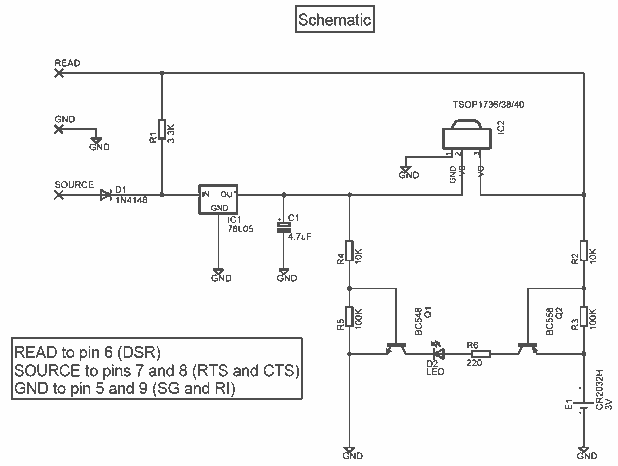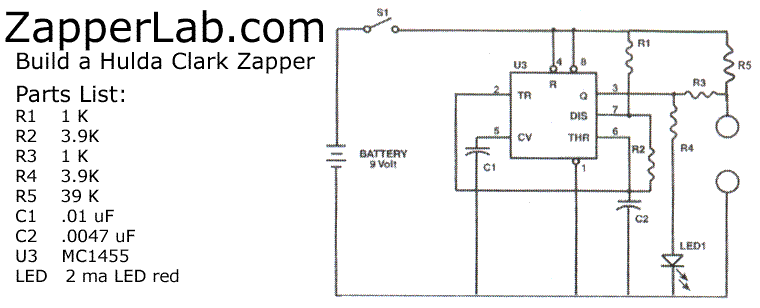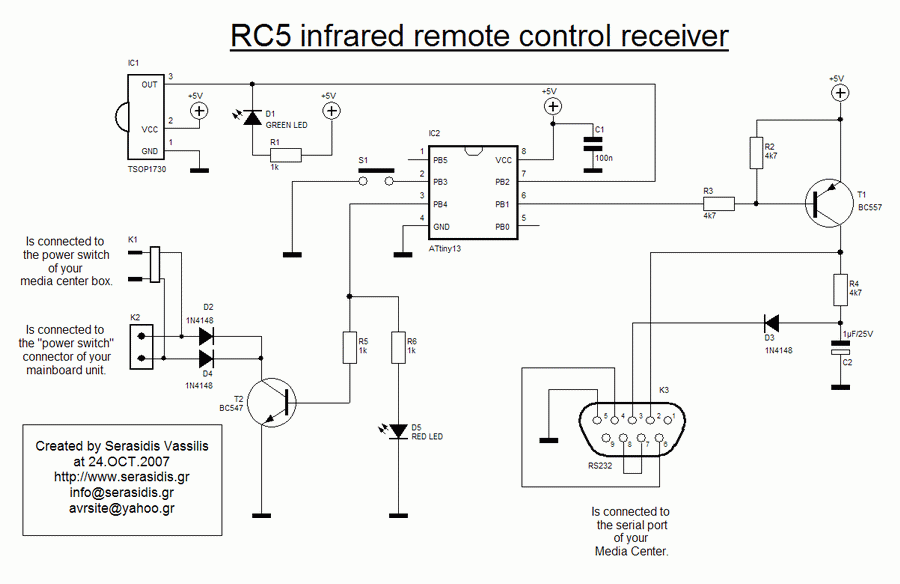
Pulse Circuits for Infrared LEDs and Visible Diode Lasers
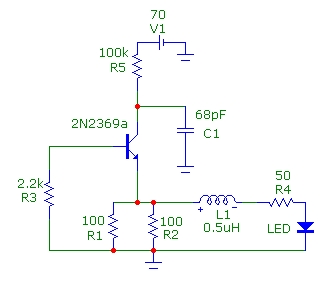
This article presents basic circuits for pulsing infrared LEDs and low-power visible semiconductor lasers utilizing inexpensive and readily available components. Numerous interesting and practical applications are referenced, alongside several online resources. The focus of the article is on the fundamental circuits. Infrared LEDs made from GaAs or GaAlAs are discussed as PN semiconductor junction diodes that typically emit wavelengths ranging from 850 to 950 nm, with 880 and 915 nm being common options. Applications include infrared remote controls for consumer devices. Typical specifications include DC optical power output between 1 and 10 mW at DC forward currents of 20 to 100 mA, with forward voltages around 1.3 to 1.7 V. Significantly higher peak power outputs can be achieved when pulsing the LEDs with short pulses ranging from 1 µs to 100 µs at low duty cycles of 1 to 10%. The optical pulse rise and fall times for these LEDs range from approximately 500 ns to 20 ns, corresponding to bandwidths of about 1 MHz to 20 MHz. Visible semiconductor lasers found in standard laser pointers emit at approximately 650 ± 20 nm and are generally classified as Class IIIA Laser Products, emitting less than 5 mW under DC bias conditions from 4.5 to 6.0 V, powered by three or four 1.5 V button cells. Visible LEDs at this wavelength are also commonly employed in audio digital optical output interfaces (S/PDIF), though power levels are typically around 30 µW. The laser chips in most inexpensive laser pointers often lack protection or biasing circuitry and have reported modulation bandwidths of several hundred MHz, significantly extending their range of applications compared to pulsed LEDs. Laser pointers are frequently available at retail outlets at low prices, often under $5.00. Many of these pointers can be disassembled and repurposed for pulsed applications as demonstrated. However, due to the high power density at the laser chip facet, these semiconductor laser devices are vulnerable to catastrophic damage from transient current "glitches" in electronic pulser circuits, necessitating careful examination of the electronic driver pulse signal, utilizing appropriate low-value resistors prior to connecting the visible laser. Suitable photodetectors for studying pulsed infrared LEDs and visible diode lasers include high-speed Si PIN diodes with fast rise and fall times of less than 10 ns. Si phototransistors provide high sensitivity with current gain but generally exhibit slower speeds, typically exceeding 200 ns. Many infrared GaAlAs LEDs can be driven at currents nearing 1000 mA, provided that the duty cycle and pulse width are sufficiently short to maintain average power dissipation within acceptable limits. By employing a standard 555 timer IC and a 2N2222A NPN transistor, it is feasible to create drive pulses with widths down to a few microseconds and amplitudes up to about 800 mA. The 555 timer chip has a rise and fall time of approximately 100 ns and a current drive capability of 200 mA. The transistor output driver enhances the output drive capability by a factor of four. The accompanying diagram illustrates the implementation of this approach. The 555 timer circuit utilizes 1N914 switching diodes to enable complete control over the on/off timing of the pulse. Despiking and power supply decoupling capacitors of 0.1 µF and 5 µF are incorporated. A 220-ohm series resistor in the 2N2222A base circuit sets the base drive level, while a 10-ohm collector resistor provides appropriate current limiting. The LED in the emitter circuit is shunted with a parallel 100-ohm resistor to accelerate the fall time of charge drain. The 555 timer and transistor are biased at the same adjustable level using a common power supply (22-121 Micronta Adjustable Dual Tracking DC power supply rated at 1 Amp and 15 V).
The described circuit effectively demonstrates the principles of driving infrared LEDs and visible semiconductor lasers with precise control over pulse characteristics. The use of a 555 timer allows for versatile pulse width modulation, which is critical for applications requiring specific timing and power levels. The integration of the 2N2222A transistor amplifies the current drive capabilities, ensuring that the LEDs operate efficiently within their specified parameters. The design also emphasizes the importance of component selection, such as the use of 1N914 diodes for switching and the implementation of appropriate resistors for current limiting and base drive control. The careful consideration of rise and fall times, as well as the inclusion of despiking capacitors, further enhances the reliability and performance of the circuit, making it suitable for a variety of applications in optical communication and remote control systems.This article demonstrates basic circuits for pulsing infrared LEDs and low power visible semiconductor lasers using components which are inexpensive and fairly readily available. Many interesting and useful applications can be found in the references cited here, as well as several online web pages.
This article focuses on the basic circuits. The i nfrared LEDS fabricated from GaAs or GaAlAs discussed here are PN semiconductor junction diodes fabricated from GaAlAs or GaAs and typically emit at wavelengths in the range 850 - 950 nm (with 880 and 915 nm being two readily available choices). Uses include infrared remote controls for consumer appliances. Typical specifications are DC optical power output ranging from 1 to 10 mW at DC forward currents of 20 to 100 mA with forward voltages from about 1.
3 to 1. 7 V. Considerably higher peak power outputs can be achieved if the LEDs are pulsed with short pulses in the range of 1 us to 100 us with low duty cycles of 1 to 10%. Optical pulse rise/fall times available from these LEDs range from ~ 500 ns to 20 ns (corresponding to bandwidths on the order of 1 MHz to 20 MHz).
Visible semiconductor lasers found in common laser pointers emit at about 650 +- 20 nm and are commonly in the Class IIIA Laser Product category, emitting less than 5 mW under DC bias conditions from 4. 5 to 6. 0 V powered by three or four 1. 5V button cells. (Visible LEDS at this wavelength are also commonly used in audio digital optical output interfaces (S/PDIF) but power levels are only about 30 microWatts).
Evidently the laser chips in most low cost laser pointers use no protection or biasing circuitry at all and the chips are reported to have modulation bandwidths of several hundred MHz extending the range of useful application considerably beyond that available with pulsed LEDS. Laser pointers can often be found at retail outlets at steep discount prices (often less than $5. 00). Many such pointers can easily be disassembled and pressed into pulsed service as demonstrated here. However, due to the nature of the semiconductor laser device (high power density at the laser chip facet), these emitters are susceptible to catastrophic damage due to transients current "glitches" in electronic pulser circuits and care should be taken to study the electronic driver pulse signal, using suitable low value resistors, before connecting the visible laser.
Photodectors suitable for studying pulsed infrared LEDS and visible diode lasers include high-speed Si PIN diodes with fast rise and fall times of less than 10 ns. Si phototransistors offer high sensitivity (with current gain) but typically have considerably lower speed, typically in excess of 200 ns.
Many infrared GaAlAs LEDS can be driven at currents approaching 1000 mA provided that the duty cycle and pulse width is short enough to keep the average power dissipation low enough. Using a standard 555 timer IC and a 2N2222a NPN transistor, it is possible to create a drive pulse with width down to a few microseconds and amplitude to about 800 mA.
The 555 timer chip has a rise/fall time of about 100 ns and current drive capability of 200 mA. The transistor output driver raises the output drive capability by about a factor of 4. The diagram below shows an implementation of this approach. The 555 timer circuit uses 1N914 switching diodes to enable complete control of the on/off time for the pulse. Despiking and power supply decoupling capacitors of 0. 1 and 5 uF were used. A 220 ohm series resistor in the 2N2222a base circuit is used to set the base drive level. A 10 ohm collector resistor provides suitable current limiting. The LED in the emitter circuit is shunted with a parallel 100 ohm shunt resistor to speed up the fall time of charge drain.
The 555 and transistor were biased at the same adjustable level with a common power supply (22-121 Micronta Adjustable Dual Tracking DC power supply rated at 1 Amp and 15 V 🔗 External reference
The described circuit effectively demonstrates the principles of driving infrared LEDs and visible semiconductor lasers with precise control over pulse characteristics. The use of a 555 timer allows for versatile pulse width modulation, which is critical for applications requiring specific timing and power levels. The integration of the 2N2222A transistor amplifies the current drive capabilities, ensuring that the LEDs operate efficiently within their specified parameters. The design also emphasizes the importance of component selection, such as the use of 1N914 diodes for switching and the implementation of appropriate resistors for current limiting and base drive control. The careful consideration of rise and fall times, as well as the inclusion of despiking capacitors, further enhances the reliability and performance of the circuit, making it suitable for a variety of applications in optical communication and remote control systems.This article demonstrates basic circuits for pulsing infrared LEDs and low power visible semiconductor lasers using components which are inexpensive and fairly readily available. Many interesting and useful applications can be found in the references cited here, as well as several online web pages.
This article focuses on the basic circuits. The i nfrared LEDS fabricated from GaAs or GaAlAs discussed here are PN semiconductor junction diodes fabricated from GaAlAs or GaAs and typically emit at wavelengths in the range 850 - 950 nm (with 880 and 915 nm being two readily available choices). Uses include infrared remote controls for consumer appliances. Typical specifications are DC optical power output ranging from 1 to 10 mW at DC forward currents of 20 to 100 mA with forward voltages from about 1.
3 to 1. 7 V. Considerably higher peak power outputs can be achieved if the LEDs are pulsed with short pulses in the range of 1 us to 100 us with low duty cycles of 1 to 10%. Optical pulse rise/fall times available from these LEDs range from ~ 500 ns to 20 ns (corresponding to bandwidths on the order of 1 MHz to 20 MHz).
Visible semiconductor lasers found in common laser pointers emit at about 650 +- 20 nm and are commonly in the Class IIIA Laser Product category, emitting less than 5 mW under DC bias conditions from 4. 5 to 6. 0 V powered by three or four 1. 5V button cells. (Visible LEDS at this wavelength are also commonly used in audio digital optical output interfaces (S/PDIF) but power levels are only about 30 microWatts).
Evidently the laser chips in most low cost laser pointers use no protection or biasing circuitry at all and the chips are reported to have modulation bandwidths of several hundred MHz extending the range of useful application considerably beyond that available with pulsed LEDS. Laser pointers can often be found at retail outlets at steep discount prices (often less than $5. 00). Many such pointers can easily be disassembled and pressed into pulsed service as demonstrated here. However, due to the nature of the semiconductor laser device (high power density at the laser chip facet), these emitters are susceptible to catastrophic damage due to transients current "glitches" in electronic pulser circuits and care should be taken to study the electronic driver pulse signal, using suitable low value resistors, before connecting the visible laser.
Photodectors suitable for studying pulsed infrared LEDS and visible diode lasers include high-speed Si PIN diodes with fast rise and fall times of less than 10 ns. Si phototransistors offer high sensitivity (with current gain) but typically have considerably lower speed, typically in excess of 200 ns.
Many infrared GaAlAs LEDS can be driven at currents approaching 1000 mA provided that the duty cycle and pulse width is short enough to keep the average power dissipation low enough. Using a standard 555 timer IC and a 2N2222a NPN transistor, it is possible to create a drive pulse with width down to a few microseconds and amplitude to about 800 mA.
The 555 timer chip has a rise/fall time of about 100 ns and current drive capability of 200 mA. The transistor output driver raises the output drive capability by about a factor of 4. The diagram below shows an implementation of this approach. The 555 timer circuit uses 1N914 switching diodes to enable complete control of the on/off time for the pulse. Despiking and power supply decoupling capacitors of 0. 1 and 5 uF were used. A 220 ohm series resistor in the 2N2222a base circuit is used to set the base drive level. A 10 ohm collector resistor provides suitable current limiting. The LED in the emitter circuit is shunted with a parallel 100 ohm shunt resistor to speed up the fall time of charge drain.
The 555 and transistor were biased at the same adjustable level with a common power supply (22-121 Micronta Adjustable Dual Tracking DC power supply rated at 1 Amp and 15 V 🔗 External reference
Warning: include(partials/cookie-banner.php): Failed to open stream: Permission denied in /var/www/html/nextgr/view-circuit.php on line 713
Warning: include(): Failed opening 'partials/cookie-banner.php' for inclusion (include_path='.:/usr/share/php') in /var/www/html/nextgr/view-circuit.php on line 713
